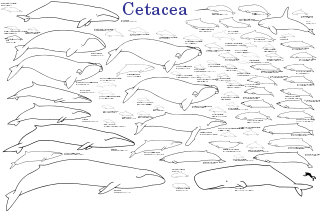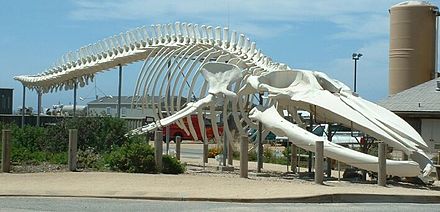
Los cetáceos (del latín cetus , « ballena » ; del griego antiguo κῆτος ( kêtos ), « pez enorme ,monstruo marino » ) son un infraorden de mamíferos acuáticos perteneciente al orden Artiodactyla que incluye a las ballenas , los delfines ylas marsopas . Sus características principales son su estilo de vida completamente acuático,su forma aerodinámica , su gran tamaño y su dieta exclusivamente carnívora . Se impulsan a través del agua con un poderoso movimiento hacia arriba y hacia abajo de su cola que termina en una aleta similar a un remo, utilizando sus extremidades anteriores en forma de aleta para maniobrar.
Si bien la mayoría de los cetáceos viven en ambientes marinos, un pequeño número reside únicamente en agua salobre o dulce . Al tener una distribución cosmopolita , se los puede encontrar en algunos ríos y en todos los océanos de la Tierra, y muchas especies habitan vastas áreas de distribución a las que migran con el cambio de estaciones.
Los cetáceos son famosos por su gran inteligencia , su comportamiento social complejo y el enorme tamaño de algunos de sus miembros. Por ejemplo, la ballena azul alcanza una longitud máxima confirmada de 29,9 metros y un peso de 173 toneladas, lo que la convierte en el animal más grande que se haya conocido.
Existen aproximadamente 89 especies vivientes divididas en dos parvórdenes : Odontoceti o ballenas dentadas (que incluyen marsopas , delfines , otras ballenas depredadoras como la beluga y el cachalote , y los poco comprendidos zifios ) y los Mysticeti o ballenas barbadas que se alimentan por filtración (que incluyen especies como la ballena azul , la ballena jorobada y la ballena de Groenlandia ). A pesar de sus cuerpos altamente modificados y su estilo de vida carnívoro, la evidencia genética y fósil ubica a los cetáceos dentro de los ungulados de dedos pares , más estrechamente relacionados con los hipopótamos dentro del clado Whippomorpha . ( Artículo completo... )
.jpg/440px-Adult_false_killer_whale_off_Guam_photographed_prior_to_deployment_of_satellite_tag_ID-_128887_(anim252541873).jpg)






Un esqueleto de ballena azul , afuera del Laboratorio Marino Long en la Universidad de California, Santa Cruz .
Las ballenas azules son los animales más grandes que han existido jamás. La caza de ballenas azules ha provocado una grave disminución de su población en todo el mundo.



El contenido que estás leyendo fue creado por voluntarios de Wikipedia. Consulta WikiProject Cetaceans para obtener más información.
Para obtener listas adicionales de artículos destacados y buenos artículos relacionados con la vida marina, consulte:
Los siguientes proyectos hermanos de la Fundación Wikimedia proporcionan más información sobre este tema: